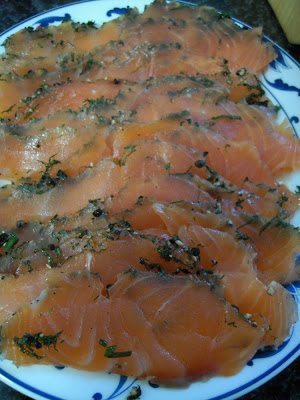Gravlax derives from Scandinavia and is a very simple process of dry-curing by marinading in salt, sugar, pepper and Dill. The result is a delicious dark, firm dill salmon perfect for Christmas or Boxing Day starter.
Firstly your salmon needs to be fresh as it could be up to twelve days old when finally consumed. When buying salmon from your fish monger look for bright and visually appealing fillets. Avoid fillets that show signs of:
Gapping – The flakes of fish appearing to be open. Commonly seen along the line of pin boning or on the fattier sections of the belly flap. Gapping is a sign of old fish.
Soft texture – Old or badly handled salmon will be soft to the touch. If you can press your finger onto the skin and the indentation remains or retracts slowly the fish is to be avoided. Bare in mind if the fish has been scalled the fish will feel slightly softer to the touch so a little leeway should be given.
Patching or lightening of colour – If the salmon has lighter colour patches on the flesh this is probably due to ice burn or water absorption. This is usually a result of poor handling. Although this has probably not affected the freshness and it would cook fine it is not ideal to use for gravlax.
Gravlax requires two matching pieces of salmon fillet with identical thicknesses. This is not the easiest to obtain unless you are great friends with you fishmonger, therefore I would suggest ordering the whole fish (a 4kg head on gutted salmon will yield two skin on sides of approximately 1kg each) then have your fishmonger scale and fillet it for you. When at home you can cut and match your own size. Don’t forget to take the bones as you can scrape enough meat from the frame to make wonderful fishcakes.
For every 1 kg of salmon cured you will need the following ingredients;
1 medium/large bunch of dill chopped
65grms coarse sea salt
50grms white sugar
1 ½ tablespoons of crushed white peppercorns
1. mix all of the above ingredients together
2. lay one of the salmon fillets skin side down on a large piece of cling film
3. cover the upwards facing flesh evenly with the mixed ingredients
4. place the second fillet flesh down on top of the first
5. wrap tightly three or four times with cling film
In the past I have experienced a problem when the marinade (the marinade is produced when the salt draws the water from the fish which then mixes with the other ingredients) leaks from the wrap. Recently I have found better success just wrapping tightly in a food bag. Once wrapped place on a tray and put into the fridge turning every twelve hours. You can place a weighted plate directly on top which helps by forcing the fillets together. The salmon can be cured in the fridge for up to seven days, but I usually do around five. Once cured it has a further shelf life of five days.
When cured the salmon calves easily due to its now firm nature. Try to cut thinly, however not as this as regular smoked salmon. There are some great ready made dill sauces than can be served as an accompaniment but I tend to use creamy sauces such as horseradish and mustard as it balances nicely against the dill marinade.
So there you have it one of the easiest, yet most striking fish starters you can make. Once you have mastered the simple version you can move onto varying the cures to suit your own taste.
Beetroot Cured Salmon






No comments:
Post a Comment